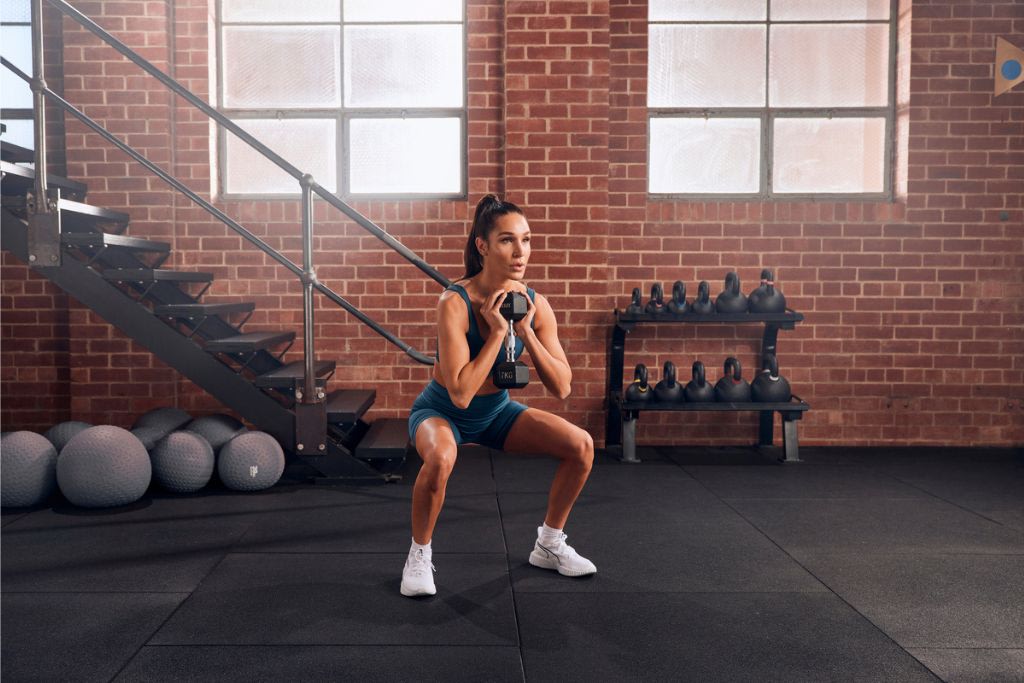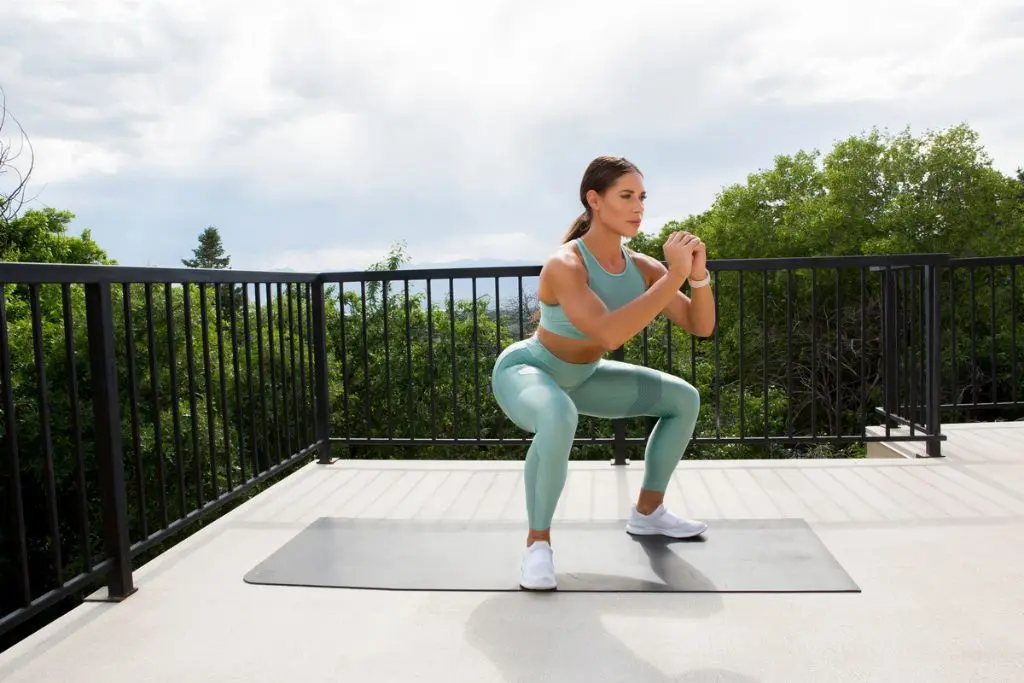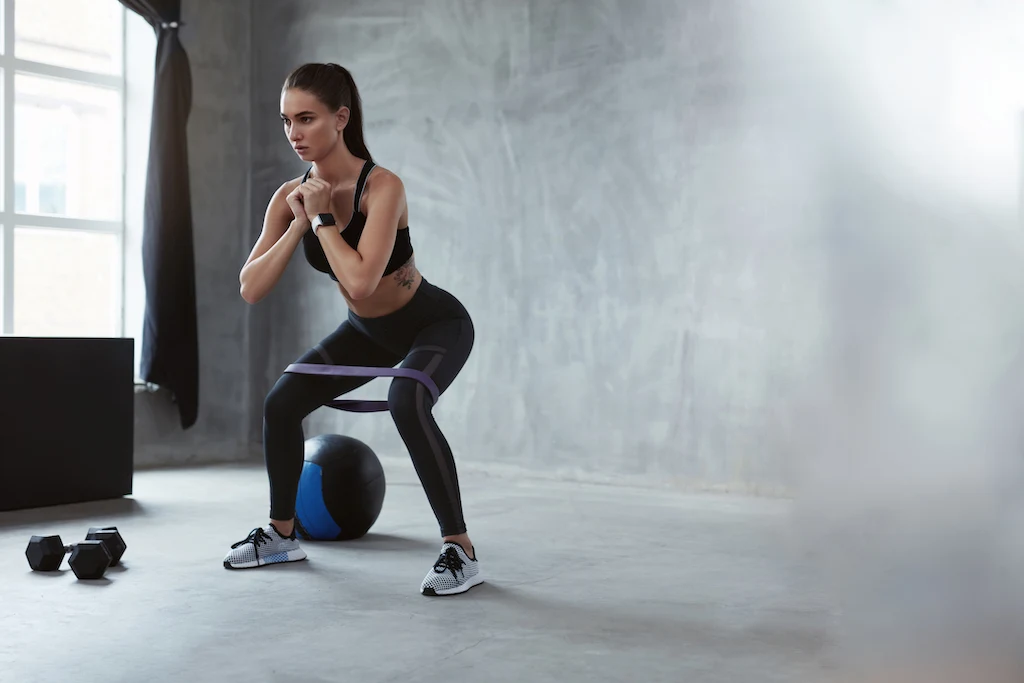How To Squat: Your Essential Guide To Proper Squat Form

April 21, 2020

Squats are one of the most popular and well-known strength training exercises here at Sweat, and for good reason. This versatile movement is incredibly beneficial for your overall health. And it’s not just your glutes that are benefiting: squats help strengthen multiple lower body and core muscle groups simultaneously, while also improving mobility, body composition, bone and joint health.
Despite being a simple movement, it’s important to learn the correct form when performing squats to ensure you reap the benefits, avoid injury, get the most out of your workout, and can safely add additional weight if you choose to.
Find out:
What are squats?
Squats are a functional movement designed to strengthen your glutes, quads, hamstrings and core at the same time. They can be done as a bodyweight exercise or with added weights, making them a versatile and useful movement to have in your workout arsenal, no matter what training style you prefer. There are multiple variations you can try which help to place more of an emphasis on particular muscles.

What are the benefits of squats?
From improving muscle strength and engaging multiple major muscle groups at once to increasing overall mobility, you’re about to find out why squats are such a popular move!
Squats work on many muscles at once
Squats have a reputation for being an incredible compound exercise as they engage several major muscle groups at the same time. So what muscles do squats work? They not only strengthen your glutes and quads, but work almost all of your lower body muscles such as your hamstrings and calves, plus your core and back to stabilise the movement, particularly when loaded with a barbell. Performing squats equals BIG bang for your buck.
Improved mobility
Part of the process of learning to squat, progressing your squats and getting the most out of every rep is learning how to squat deeply. The deeper you are able to squat, the greater your range of motion and strength gains (we love to see you squat to a depth where your upper legs are parallel with the floor).
If you’re just starting out and achieving good depth is a challenge, that’s ok! Keep practicing and work on your mobility and flexibility before you add extra weight. Including dynamic stretches in your warm-up and static stretches in your cool-down can also help.
Strengthened joints and bones
Squats aren’t just about strengthening your muscles - they also help improve joint and bone health, which is important for maintaining your active lifestyle as you get older and avoiding osteoporosis!
When performed correctly, squats can help strengthen your knees, ankles and hips in one movement, strengthening these joints in the process. If you’re experiencing joint pain during your squats, check your form in a mirror or with a gym staff member, or consider seeing a specialist.
Squats can be done with or without equipment
In their most basic form, squats can be done without any equipment as a simple bodyweight squat. This means you can do them almost anywhere — whether you’re in the gym, the park or working out at home.
If you want to dial up the difficulty to build your strength, it’s simple! You can add whatever weights you prefer or have access to, such as dumbbells, a kettlebell, a medicine ball, or a weighted barbell for back squats. Adding weight will also add an extra challenge for your core and posterior chain (the muscles down the backside of your body) as they work harder to stabilise the movement.
Exercise: Sit Squat - Kayla Itsines
How to do squats: Mastering proper squat form
Ensuring you use proper form will allow you to get the most out of your squats by building muscle and reducing the risk of injury.
The best squat technique for beginners is the sit or box squat. This involves utilising a chair or box as a fixed point to aim for while helping you emphasise the motion of driving your hips back and down rather than initiating the movement at the knees or arching your back.
Here’s a step-by-step guide:
Place a chair or low box behind you and begin standing facing away from the chair, with both feet on the floor hip-width apart.
Inhale and engage your core by thinking about drawing your belly button towards your spine. Looking straight ahead, bend at both the hips and knees, ensuring that your knees remain in line with your toes. Continue bending, driving your hips back and bending your knees until you are able to lightly sit on the chair behind you, keeping your shoulders back and chest proud to avoid hunching throughout the movement.
Exhale as you push through your heels and extend your hips and knees simultaneously to return to the starting standing position. You should feel the tension in your glutes, quads and hamstrings.
This will form the foundation of all squat variations and is a good point to build from. Once you've mastered the sit squat, move onto a bodyweight squat and replicate the same technique - minus the chair or box. Here you can start to practice working on your depth and getting your upper legs parallel with the floor. Once you’ve mastered the bodyweight squat, it’s up to you whether you want to try adding weights!

Different squat variations
There are many different types of squats you can do. Each of these squat variations work your lower body muscles in a different way, change the complexity of the movement, or increase the intensity.
Exercise: Bulgarian Split Squat - Chontel Duncan
Bulgarian split squat
The Bulgarian split squat is great for strengthening your glutes and quads in a targeted way, as it places greater focus on hip stabilisation and single-leg strength, compared to a conventional squat. You’ll need a bench, low box or a sturdy chair to do this exercise. Word of warning - these burn.
Stand in front of the bench, and carefully place your foot behind you onto the bench (with the ball of your foot facing towards the sky).
Bend both your knees to a 90-degree angle, making sure your front knee doesn’t extend over your toes. Your front knee should be in-line with your ankle once you get to the bottom of the movement, so you may need to step further away from the bench. This exercise can be done with dumbbells if you’d like to make it more challenging.
Exercise: Front Squat - Kelsey Wells
Weighted front squat
Another common variation is the front squat which can be performed with a barbell or dumbbells. To start, position yourself with your feet shoulder-width apart, then hold your dumbbells up near your shoulders, with your palms facing towards each other. Proceed through the squat movement as usual.
If you’re using a barbell, it can be a little trickier to get your positioning right, so it’s best to start light or with an empty barbell to master your form. Check out these step-by-step instructions here!
Exercise: Bodyweight Sumo Squats - Kelsey Wells
Sumo squat
The main difference with a sumo squat is that your feet are placed further than shoulder-width apart and turned out to 45 degrees, which can put more emphasis on your glutes and inner thigh muscles.
Like other squats, this exercise can be made more challenging by adding weights.
Exercise: Single Leg Box Squat - Kelsey Wells
Single-leg box squat
A single-leg box squat is a great way to challenge your stability and target your glutes, hamstrings and quads in a new way. They’re typically performed with a box, but you can easily give it a go with a chair or bench, too.
Simply put a sturdy chair or bench behind you and place your feet shoulder-width apart. Extend one of your legs out in front of you so you are balancing on one foot, then move through the squat movement, coming down to sit lightly on the chair behind you before coming straight back up. Repeat for your specified number of reps, then switch legs.
Exercise: Goblet Squat - Chontel Duncan
Goblet squats
In a goblet squat, you’ll be holding a kettlebell or a dumbbell in front of your chest throughout the movement. Start by holding the kettlebell with both hands against your chest. If you have a dumbbell, hold it vertically with both hands in front of your chest. Plant your feet shoulder-width apart and move through the squat movement, ensuring the kettlebell or dumbbell remains steady.
When squatting while holding a weight in front of your chest, it’s easy to let your back and shoulders hunch over, so remember to focus on maintaining a proud chest with your shoulders back and down.
How to progress your squats
If you’re new to squats, start by doing sit squats and regular bodyweight squats, then when you feel confident, stronger and have mastered your form, you can try different variations or start to add weights.
In terms of weight and equipment progression, start with a goblet squat, holding a weight in front of your chest.
Then, you can progress to front squats, holding two dumbbells by your shoulders. Eventually, you might want to try barbell back squats, where you can start with the bar without any additional weight added. It’s important to get comfortable with each movement, nail your form, and start light before progressing to the next variation or adding extra weight. So many women in the Sweat Community love strength training and keeping track of the weight they can lift on their squats can be a great way to track progress!
Another way to progress is to perform single-leg variations such as the single-leg box squat or Bulgarian split squats. This essentially means going through the normal motions of a squat, but with one of your legs extended in front or behind you. These single-leg variations challenge your balance, core, glute and leg strength.

Common mistakes that lead to bad squat form
While squats are a simple exercise, there are some common mistakes. Here’s what NOT to do.
Knees moving in as you squat
A common error is letting your knees cave inward as you bend into the squat position. To avoid this, drive your knees outwards and make sure they are tracking over your toes. Using a resistance band around your knees can be a great way to remind you to drive your knees out and engage your glutes.
Knees going over your toes
Avoid letting your knees track further than your toes as you bend down. You should focus on hinging at the hips and sitting back into the squat position, rather than bending forward into your knees. Looking at your form in a mirror can help!
Moving through the movement too quickly
Moving through squats too quickly can impact your form, increase the risk of injury and reduce the effectiveness of the exercise. It’s vital (especially if you’re a beginner) to slow the movement down and focus on keeping your body in the correct position. Think about squatting down with control, then standing up with power.
Letting your heels lift
When standing back up from a squat, some people push through their toes and let their heels lift off the floor which is incorrect form. Focus on pushing through your heels and keeping your entire foot on the floor during squats.
Not going deep enough
When squatting, people often don’t go deep enough into the movement. Make sure you work towards getting your legs parallel to the ground (or as close to this as you can) to fully engage the muscles.
Hunching your back over
Keeping a neutral spine is very important for avoiding injury and being able to safely add more weight. Focus on keeping your shoulders back and your chest out as you move through the squat.
Butt wink
Butt wink is a common form error (as silly as it might sound), referring to your lower back rounding and your pelvis “winking” or tucking under near the bottom of your squat. This means your pelvis goes into a posterior pelvic tilt which can put excessive pressure on your spine and back - especially if you’re lifting weights. Ouch.
Not keeping your neck neutral
Bending your neck up or down can strain the muscles here, and impact your neutral spine. Try to keep your neck neutral as you move through your squat by looking straight ahead. If you want to check your form, find a mirror or film yourself rather than looking down.
Not engaging your core muscles
Many people forget to engage their core muscles when squatting. Ensuring your core is braced will help protect your back from risk of injury (especially if you’re adding weights) and give you extra power.
Get started with squats
If you’re new to squats, the best place to start is with three sets of twelve bodyweight squats, increasing the reps or adding weight as you get stronger. Remember to keep a neutral spine, and avoid the common mistakes mentioned above. Then, take your pick of any Sweat program - they all use squat movements in some shape or form!

A more empowered you starts with Sweat, and our editorial team is here to bring you the latest fitness tips, trainer recommendations, wellbeing news, nutritional advice, nourishing recipes and free workouts.
* Disclaimer: This blog post is not intended to replace the advice of a medical professional. The above information should not be used to diagnose, treat, or prevent any disease or medical condition. Please consult your doctor before making any changes to your diet, sleep methods, daily activity, or fitness routine. Sweat assumes no responsibility for any personal injury or damage sustained by any recommendations, opinions, or advice given in this article.
Fitness